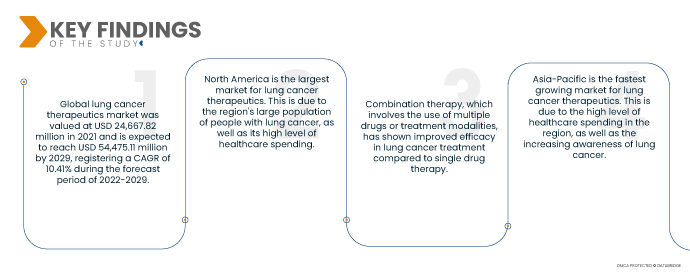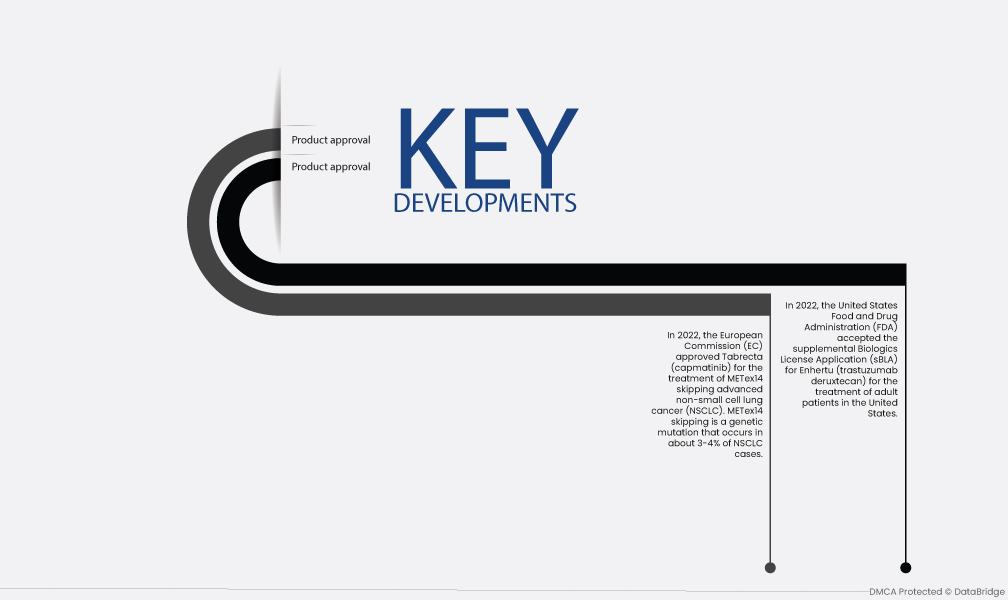Рак легких (как мелкоклеточный, так и немелкоклеточный) является вторым по частоте заболеванием как у мужчин, так и у женщин, согласно данным Американского онкологического общества 2022 года. Рак легких является основной причиной смерти от рака как у мужчин, так и у женщин, составляя более 25% всех случаев смерти от рака. Кроме того, хотя это заболевание остается основной причиной смерти от рака как среди мужчин, так и среди женщин, уровень выживаемости увеличился на 14,5% в национальном масштабе за последние пять лет, согласно отчету Американской ассоциации легких за 2021 год. В результате все эти факторы способствовали расширению рынка.
Полный отчет доступен по адресу https://databridgemarketresearch.com/reports/global-lung-cancer-therapeutics-market
Глобальный рынок терапии рака легких оценивался в 24 667,82 млн долларов США в 2021 году и, как ожидается, достигнет 54 475,11 млн долларов США к 2029 году, регистрируя среднегодовой темп роста в 10,41% в прогнозируемый период 2022-2029 годов. Ожидается, что число людей, у которых диагностирован рак легких, увеличится в ближайшие годы из-за ряда факторов, включая курение, загрязнение воздуха и старение. Стоимость лечения рака растет из-за растущей сложности лечения и роста стоимости лекарств. Растет осведомленность о раке легких как среди широкой общественности, так и среди поставщиков медицинских услуг. Это приводит к тому, что все больше людей диагностируют это заболевание и все больше людей обращаются за лечением.
Ожидается , что растущий спрос на средства для лечения рака легких будет способствовать росту рынка
Одним из основных факторов развития мирового рынка терапии рака легких является растущий спрос на лечение. Рак легких является основной причиной смерти от рака во всем мире, и ожидается, что число людей, у которых диагностировано это заболевание, увеличится в ближайшие годы. Это обуславливает спрос на новые и эффективные методы лечения. В последние годы был разработан ряд новых и эффективных методов лечения рака легких. Эти методы лечения более эффективны, чем старые методы, и они также менее токсичны. Существует ряд новых вариантов лечения рака легких, и эти варианты становятся все более доступными. Это облегчает людям с раком легких доступ к лечению.
Область отчета и сегментация рынка
Отчет Метрика
|
Подробности
|
Прогнозируемый период
|
2022-2029
|
Базовый год
|
2021
|
Исторические годы
|
2020 (можно настроить на 2014-2019)
|
Количественные единицы
|
Доход в млн. долл. США, объемы в единицах, цены в долл. США
|
Охваченные сегменты
|
Тип рака (немелкоклеточный рак легких, метастатический рак легких, легочные нейроэндокринные опухоли, опухоли средостения, мезотелиома, опухоли грудной стенки), тип молекулы (малые молекулы и биологические препараты), класс препарата (алкилирующие агенты, антиметаболиты, ингибиторы EGFR, ингибиторы митоза, ингибиторы мультикиназы и другие), тип лечения (химиотерапия, лучевая терапия, таргетная терапия, иммунотерапия и другие), тип терапии (терапия одним препаратом и комбинированная терапия), конечный пользователь (больницы, уход на дому, специализированные клиники и другие), канал распространения (больничная аптека, розничная аптека, интернет-аптеки и другие)
|
Страны, охваченные
|
США, Канада и Мексика в Северной Америке, Германия, Франция, Великобритания, Нидерланды, Швейцария, Бельгия, Россия, Италия, Испания, Турция, Остальная Европа в Европе, Китай, Япония, Индия, Южная Корея, Сингапур, Малайзия, Австралия, Таиланд, Индонезия, Филиппины, Остальная часть Азиатско-Тихоокеанского региона (APAC) в Азиатско-Тихоокеанском регионе (APAC), Саудовская Аравия, ОАЭ, Южная Африка, Египет, Израиль, Остальной Ближний Восток и Африка (MEA) как часть Ближнего Востока и Африки (MEA), Бразилия, Аргентина и Остальная часть Южной Америки как часть Южной Америки
|
Охваченные участники рынка
|
Church & Dwight Co., Inc. (США), GlaxoSmithKline plc. (Великобритания), Pfizer Inc. (США), Sun Pharmaceutical Industries Ltd. (Индия), Takeda Pharmaceutical Company Limited (Япония), ONO PHARMACEUTICAL CO., LTD. (Япония), F. Hoffmann-La Roche Ltd (Швейцария), Novartis AG (Швейцария), Lily. (США), AstraZeneca (США), Boehringer Ingelheim International GmbH (Германия), Merck & Co., Inc. (США), CELGENE CORPORATION (США), Sanofi (Франция), Johnson & Johnson Services, Inc. (США), Dr. Reddy's Laboratories Ltd. (Индия), ALLERGAN (Ирландия), Teva Pharmaceutical Industries Ltd. (Израиль) и Bristol-Myers Squibb Company (США)
|
Данные, отраженные в отчете
|
Помимо таких рыночных данных, как рыночная стоимость, темпы роста, сегменты рынка, географический охват, участники рынка и рыночный сценарий, рыночный отчет, подготовленный командой Data Bridge Market Research, включает в себя углубленный экспертный анализ, эпидемиологию пациентов, анализ воронки продаж, анализ цен и нормативную базу.
|
Анализ сегмента:
Мировой рынок средств для лечения рака легких подразделяется на семь основных сегментов, которые различаются по типу рака, типу молекулы, классу препарата, типу лечения, типу терапии, конечному пользователю и каналу сбыта.
- В зависимости от типа рака мировой рынок терапевтических средств для лечения рака легких сегментируется на немелкоклеточный рак легких, метастатический рак легких, легочные нейроэндокринные опухоли, опухоли средостения, мезотелиому и опухоли грудной стенки.
Ожидается, что сегмент немелкоклеточного рака легких будет доминировать на мировом рынке терапии рака легких.
Прогнозируется, что сегмент немелкоклеточного рака легких будет лидировать с долей рынка 49,2%. Немелкоклеточный рак легких является наиболее распространенным типом рака легких, на который приходится большинство случаев рака легких. Он имеет более высокий уровень заболеваемости по сравнению с другими типами рака легких, что способствует его доминированию на рынке.
- На основе типа молекулы глобальный рынок терапии рака легких сегментирован на малые молекулы и биопрепараты. Доминирующий сегмент в категории типа молекулы может зависеть от таких факторов, как доступность одобренных методов лечения, фокус на исследованиях и разработках и рыночные предпочтения, основанные на профилях эффективности и безопасности.
- На основе класса лекарств мировой рынок терапевтических средств для лечения рака легких сегментируется на алкилирующие агенты , антиметаболиты, ингибиторы EGFR, митотические ингибиторы , ингибиторы мультикиназы и другие. Прогнозируется, что сегмент алкилирующих агентов будет лидировать с долей 30,6%. Алкилирование напрямую повреждает ДНК и предотвращает деление раковых клеток. Алкилирующий агент может использоваться на любой стадии рака. Этот препарат показывает пред- и постстадию. Этот препарат также показывает сниженное накопление лекарств и повышенную детоксикацию.
- На основе типа лечения глобальный рынок терапии рака легких сегментируется на химиотерапию, лучевую терапию, таргетную терапию, иммунотерапию и другие. Прогнозируется, что сегмент химиотерапии будет лидировать с долей рынка 39,6%. Он предлагает потенциал для персонализированных подходов к лечению и улучшенных результатов, что способствует его доминированию на рынке.
- На основе типа терапии глобальный рынок терапии рака легких сегментируется на терапию одним препаратом и комбинированную терапию. Прогнозируется, что сегмент терапии одним препаратом будет лидировать с долей рынка 61,0%.
- По признаку конечного потребителя мировой рынок средств для лечения рака легких сегментируется на больницы, учреждения по уходу на дому, специализированные клиники и другие.
Ожидается, что сегмент больниц будет доминировать на мировом рынке терапии рака легких
Ожидается, что сегмент больниц будет доминировать на мировом рынке терапии рака легких с долей рынка 45,9%. Больницы служат первичным медицинским учреждением для диагностики и лечения рака легких. Они обладают необходимой инфраструктурой, медицинским опытом и ресурсами для предоставления комплексной помощи пациентам с раком легких, что способствует их доминированию в качестве первичного сегмента конечного пользователя.
- На основе канала сбыта глобальный рынок терапевтических средств для лечения рака легких сегментируется на больничную аптеку, розничную аптеку, интернет-аптеку и другие. Прогнозируется, что больничная аптека будет лидировать с долей рынка 52,2%. Больничная аптека доминирует на мировом рынке терапевтических средств для лечения рака легких, поскольку продукты для лечения рака легких выдаются по рецепту, что в основном доступно в больничной аптеке.
Основные игроки
Data Bridge Market Research выделяет следующие компании в качестве основных игроков рынка: Church & Dwight Co., Inc. (США), GlaxoSmithKline plc. (Великобритания), Pfizer Inc. (США), Sun Pharmaceutical Industries Ltd. (Индия), Takeda Pharmaceutical Company Limited (Япония), ONO PHARMACEUTICAL CO., LTD. (Япония), F. Hoffmann-La Roche Ltd (Швейцария), Novartis AG (Швейцария), Lily. (США), AstraZeneca (США), Boehringer Ingelheim International GmbH (Германия), Merck & Co., Inc. (США), CELGENE CORPORATION (США), Sanofi (Франция), Johnson & Johnson Services, Inc. (США), Dr. Reddy's Laboratories Ltd. (Индия), ALLERGAN (Ирландия), Teva Pharmaceutical Industries Ltd. (Израиль) и Bristol-Myers Squibb Company (США).
Развитие рынка
- В 2022 году Европейская комиссия (ЕК) одобрила препарат Табректа (капматиниб) для лечения METex14 skipping при прогрессирующем немелкоклеточном раке легких (НМРЛ). METex14 skipping — это генетическая мутация, которая встречается примерно в 3–4 % случаев НМРЛ. Табректа — это ингибитор киназы, нацеленный на ген MET, и, как было показано, он эффективен у пациентов с METex14 skipping при НМРЛ. Табректа — это таблетка для приема один раз в день, которую принимают внутрь. Препарат обычно хорошо переносится, наиболее распространенными побочными эффектами являются диарея, тошнота и рвота.
- В 2022 году Управление по контролю за продуктами и лекарствами США (FDA) приняло дополнительную заявку на лицензию на биологические препараты (sBLA) для Enhertu (трастузумаб дерукстекан) для лечения взрослых пациентов в США с неоперабельным или метастатическим НМРЛ. Enhertu — это конъюгат антитела и препарата, нацеленный на HER2, который, как было показано, эффективен у пациентов с HER2-положительным НМРЛ. Enhertu вводится в виде внутривенной инфузии каждые три недели. Он может вызывать более серьезные побочные эффекты, такие как инфузионные реакции, цитопении и пневмонит.
Региональный анализ
Географически в отчете о рынке рассматриваются следующие страны: США, Канада и Мексика в Северной Америке, Германия, Франция, Великобритания, Нидерланды, Швейцария, Бельгия, Россия, Италия, Испания, Турция, остальные страны Европы в Европе, Китай, Япония, Индия, Южная Корея, Сингапур, Малайзия, Австралия, Таиланд, Индонезия, Филиппины, остальные страны Азиатско-Тихоокеанского региона (APAC) в Азиатско-Тихоокеанском регионе (APAC), Саудовская Аравия, ОАЭ, Южная Африка, Египет, Израиль, остальные страны Ближнего Востока и Африки (MEA) как часть Ближнего Востока и Африки (MEA), Бразилия, Аргентина и остальные страны Южной Америки как часть Южной Америки.
Согласно анализу Data Bridge Market Research:
Северная Америка будет доминирующим регионом на рынке терапии рака легких в прогнозируемый период 2022-2029 гг.
Северная Америка является крупнейшим рынком для терапии рака легких. Это связано с большой численностью населения региона, страдающего раком легких, а также высоким уровнем расходов на здравоохранение.
По оценкам, Азиатско-Тихоокеанский регион станет самым быстрорастущим регионом на рынке терапии рака легких в прогнозируемый период 2022–2029 гг.
Азиатско-Тихоокеанский регион является самым быстрорастущим рынком для терапии рака легких. Это связано с высоким уровнем расходов на здравоохранение в регионе, а также с растущей осведомленностью о раке легких.
Для получения более подробной информации об отчете о рынке терапевтических средств для лечения рака легких нажмите здесь – https://www.databridgemarketresearch.com/reports/global-lung-cancer-therapeutics-market












